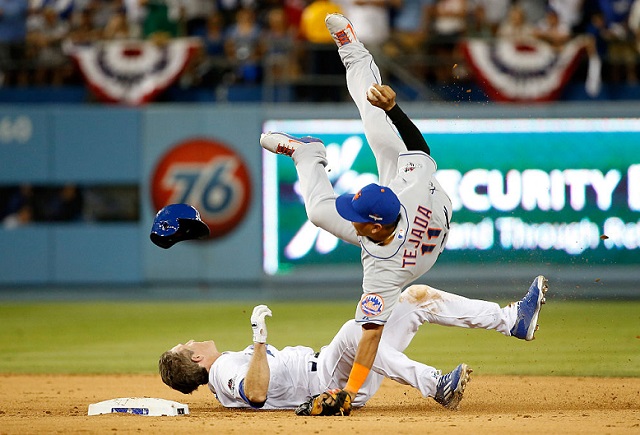One of the biggest issues Major League Baseball needed to address during the offseason was clarifying its rules about slides into second base. Takeout slides and subsequent collisions resulted in some serious injuries last year. Just as spring training begins for the 2016 season, it appears that MLB is ready to define what constitutes a legal slide at second base.
According to Yahoo Sports’ Jeff Passan, the new — or newly defined — rule emphasizes four main points for runners and umpires to consider on such plays.
• Slide prior to reaching the base.
• Slide so you are able to and attempt to reach or touch the base.
• Slide so you are able to and attempt to stay on the base.
• Do not change your pathway to the base.
If those rules are properly enforced and followed, the days of a runner sliding into second base right at the bag and running far out of the baseline to prevent an infielder from tagging the bag or making a throw are over. Baserunners have to at least make an attempt at making a proper slide and not blatantly look to knock out the second baseman or shortstop trying to make a play.
One other change, as just announced by MLB: The "neighborhood play" will be reviewable by replay this season. Got to have a foot on the bag.
— Jeff Passan (@JeffPassan) February 25, 2016
A big obstacle to outlawing takeout slides, which was the drastic reaction to players like the Mets’ Ruben Tejada and Pirates Jung-Ho Kang suffering season-ending injuries as a result of collisions, was that runners still wanted to be able to go at infielders. That’s just good, hard, tough baseball in their view. Infielders apparently didn’t feel the need to be overly protected either, feeling the same way about playing the game hard. But as Passan’s tweet about the “neighborhood play” indicates, infielders will be held to a higher standard as well. That foot needs to touch the bag to make an out and umpires can use to replay to make sure it does.
Additionally, MLB is instituting new measures on managers and pitching coaches visiting the mound during ballgames. As Passan reports, mound visits will now be limited to 30 seconds and will be timed on a clock in the ballpark that starts as soon as the pitching coach or manager leaves the dugout.
https://twitter.com/n_thurm/status/702901890539884544
The penalty for exceeding the 30-second limit won’t exactly be stiff, however. Umpires will simply warn managers and coaches that the visit needs to end. They can’t issue an automatic ball or anything like that. But the clock is now there to tell everyone to keep the game moving. Also, teammates can still visit the mound whenever or for however long needed, so it’s not difficult to imagine that a manager won’t just tell an infielder to call time and either give the current pitcher a breather or allow a reliever more time to warm up.
One more time-saving measure that MLB will implement is cutting the between-innings clock from 2:25 to 2:05. That could conceivably save an extra six minutes each ballgame, helping last year’s pace-of-play rules to reduce the length of MLB games even further from their average of two hours, 56 minutes last season.







